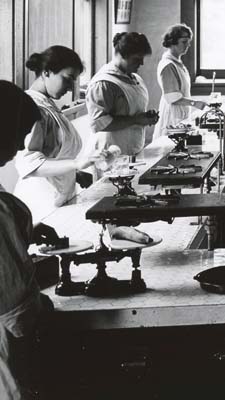
Home Economics & Food Reform
![]()
The home economics movement helped homemakers apply scientific principles
to improve conditions in their homes, institutions, and communities. By
sharing their knowledge of nutrition and hygiene through outreach programs,
home economists had a significant influence on American eating habits
in the 20th century. The impact of the movement was strengthened after
1914, when federal funding from the Smith-Lever Act established the Cooperative
Extension Service, an educational system designed to enable people to
improve their lives and communities through partnerships with experts
and institutions. Initially, many women responded skeptically to the new
ideas promoted by home economists, particularly since their emphasis on
Anglo-Saxon cooking did not reflect the rich culinary traditions of immigrant
populations.
Home economists also responded to some of the major national crises of the twentieth century. During the Great Depression, for example, they provided guidance on selecting a healthful diet with limited means. And during the two world wars, they stressed the importance of meat and sugar substitutes, the need for food preservation, and the challenge of maintaining high nutritional standards despite wartime shortages.
 |
||

Copyright
© 2002 Division of Rare & Manuscript
Collections
2B Carl A. Kroch Library, Cornell University, Ithaca, NY, 14853
Phone Number: (607) 255-3530. Fax Number: (607) 255-9524
For
reference questions, send mail to:
rareref@cornell.edu
If you have questions or comments about the site, send mail to: webmaster.